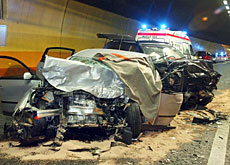Swiss drivers are soberer and safer

A lowered drink-drive limit has helped reduce serious accidents involving alcohol by more than a quarter compared with the previous year.
Federal Statistics Office figures for the first six months of 2005 also show the total number of serious road accidents in Switzerland went down by 12 per cent to 2,316.
During the same period, crashes caused by a driver under the influence of alcohol decreased by 26 per cent to 259.
Road-safety measures introduced at the beginning of the year, such as lowering the drink-drive limit from 0.8 milligrams to 0.5 milligrams per millilitre and increased random breathalysing, are believed to have had a significant effect on motorists’ behaviour.
Figures released by the Statistics Office on Tuesday also show that the number of accidents in which speeding is thought to have been a factor decreased by ten per cent to 583.
This reflects the greatest improvement since 1992.
Fatal crashes involving alcohol went down by 37 per cent to 156 and those involving excess speed by 23 per cent to 70.
The Statistics Office says the lowering of the drink-drive limit on January 1 has clearly had an effect on other driving offences – especially speeding – albeit a less significant one.
“However it’s too early to crack open the champagne,” says Werner Jeger, deputy-head of the Federal Roads Authority.
Jeger even fears that the curve will start to flatten out as people get accustomed to the new limits.
Enforcement
Intensive law enforcement by the police and a widespread awareness campaign and debate in the media are believed to have also had an influence, although the long-term effects are yet to be seen.
The number of roadside tests for alcohol administered by police has trebled.
At the end of 2004, there was a two-per-cent chance of drivers being pulled over for a random breath-test. In 2005 the figure was six per cent.
What’s more, 47 per cent of drivers pulled over in 2005 had to blow into a breathalyser, compared with 17 per cent in 2001.
The proportion of drivers with a blood-alcohol level greater than 0.8 milligrams sank from 25 per cent in 2001 to eight per cent in 2005.
swissinfo with agencies
On January 1, 2005, the Swiss blood-alcohol limit for drivers was lowered from 0.8 to 0.5 milligrams per millilitre.
A campaign launched in mid-November urged drivers not to exceed one glass.
Random breath-tests were also introduced.
The Federal Statistics Office believes a lower drink-drive limit and a widespread awareness campaign in the media have reduced the number of road accidents in Switzerland.
The total number of serious road accidents for the first six months of 2005 went down by 12 per cent compared with the previous year.
Intensive law enforcement by the police has also been a factor.

In compliance with the JTI standards
More: SWI swissinfo.ch certified by the Journalism Trust Initiative











You can find an overview of ongoing debates with our journalists here . Please join us!
If you want to start a conversation about a topic raised in this article or want to report factual errors, email us at english@swissinfo.ch.